Introduction:
In addition to their elegant look and feel, accessories made from alligator and crocodile offer functionality, durability and prestige well beyond similar items in common leather. With normal care, a quality item made from alligator or crocodile can be utilized every day and treasured for many years.
As in buying in anything of value, do some research. Because of the premium prices commanded by alligator and crocodile items, there is a great deal of mislabeling and misrepresentation of the reptile species and the quality of the skins. While it is important to be careful and only buy from people with a solid reputation, don't be discouraged from buying a beautiful gift for someone special, including yourself.
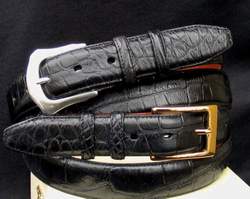
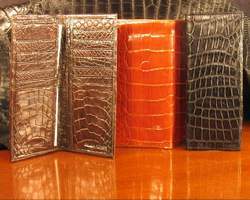
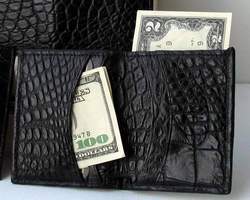
What is the difference between "Alligator" and "Crocodile" leather?
While there is essentially only one species of alligator ( the "American Alligator" or " alligator mississippiensis"), there are a dozen species of crocodiles, in varied shapes and sizes found all over the world. Alligators and all types of crocodile are endangered, threatened or otherwise protected and their commercial trade is restricted by CITES (Convention on International Trade in Endangered Species). Within the USA, the trade in these animals is especially well policed.
Alligator and crocodile leathers are similar in several ways, including their classic great looks, relative exclusivity and their ability to look great thru many years of service. However, based upon the body section of the donor animal, and the tanning and finishing processes utilized, the value and quality of the leather can vary widely. In selecting an accessory made from alligator or crocodile , it is far more important to consider the quality (scale pattern, softness, and finish) of the leather, rather than the species of the animal.
Generally speaking, (there are a number of variables discussed later), alligator skin is much nicer, with more symmetrical scale patterns, with thicker and softer skin, and with a smoother and more three-dimensional feel than the typical crocodile skin. Though relatively rare, top quality skins from the Nile Crocodile and Australian Saltwater Crocodile are the equal, and in some ways better, than the best alligator. Caiman, the most common type of crocodile, is generally the least desirable leather.
The most common mislabeling of alligator is on items made from the Brown Caiman from Central and South America. While caiman skins can be of good quality, caiman skin is relatively thinner and due to the less sophisticated tanning processes on finished products from South America, it is usually dryer, stiffer and less durable. For a buyer, it is unfortunate that this dryness cannot be seen in photos. One visual clue is that caiman can often be identified by small pits in their scales; these pits are far more common in caiman relative to other crocodiles, and is non-existent in genuine alligator.
What about the shape, size and pattern of the scales?
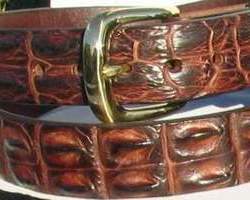
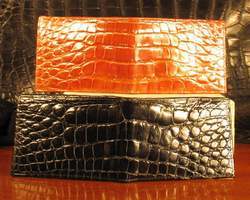
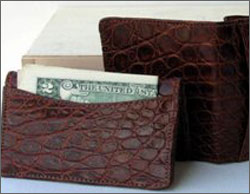
In addition to the species of alligator/crocodile, the quality of the skin varies from animal to animal and from what part of the body the skin is sourced. For smooth-skinned items, the premium sections include the central belly and throat areas where the scales are the largest and the most symmetrical around the center-line of the belly: these scales are somewhat rectangular in shape. The sides (or flanks) can also be very good quality; skin from the sides has scales that are rounded in shape and the skin is a bit thinner. The least desirable section is the tail (which represents about 50% of the animal's length); the tail skin is stiffer, has more widely spaced scales, and is more heavily scared (scarring is normal and validates that the skin is genuine; a little scarring is interesting). The best portions of the tail are suitable for belts or the internal sections of a wallet or purse.
The size of the donor animal is also important. This can offer a clue to distinguish alligator from caiman, since caiman skins usually come from smaller animals (3 to 5 feet in length; compared to 6 to 12 feet for the typical alligator or Nile Croc). With a smaller donor animal, the pattern and size of the scales transitions rapidly over the small area of the wallet or purse, such that the shape of the crocodile's body/head/tail is clearly apparent; this can be a good thing depending on the application.
While the scale pattern on all alligators and crocodiles is symmetrical relative to the centerline of the body, the scale pattern on alligators can be characteristically different than the scale pattern on crocodiles (note: each species of crocodile has somewhat unique body shape and scale pattern). The size of the scales on an alligator are more directly related to the length of the animal, such that the largest belly scales on a typical 10 foot alligator are well over one-inch square; additionally, the scales on an alligator's centerline can be noticeably larger than the size of the scales just off the centerline. In contrast, the size of the scales on a crocodile tend to be less variable (or less linear) relative to the animal's length; for example, on a 10 foot crocodile, the largest belly scales may remain under one-inch "square" (and are typically a bit less square than an alligator's scales.) Also, generally speaking, all of the scales on a crocodile's belly are more uniformly sized than on an alligator.
Once a full alligator/crocodile hide has been cut and processed into a final product, the species of the donor animal is in doubt. While the quality of the leather is apparent (again quality is the most important issue), the species is not. Given that the alligator/crocodile accessory usually represents a relatively small piece of leather from a much larger animal, and there is a great deal of variation in the scale pattern from one individual animal to another, and from the area of the body where the leather is sourced, it may be virtually impossible to determine the species. An "Genuine Alligator" or "Genuine Crocodile" stamp is of little comfort. This is another reminder to only buy from trusted suppliers, and to primarily focus on quality.
What about the "CLASSIC" (high-gloss) versus the "SAFARI" (semi-gloss and more natural) finish?
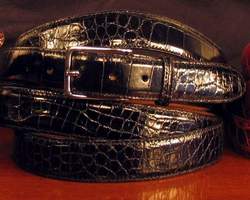
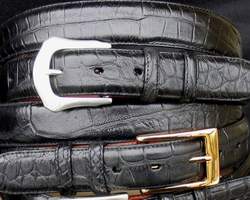
Alligator and crocodile skins are available in a variety of colors and in two primary types of finishes, the CLASSIC high-gloss, and the SAFARI gloss or semi-gloss. Your choice of finish should depend upon the application and the type of accessory.
The CLASSIC finish is the more processed, smooth shiny patent leather look that was historically associated with the finest quality exotic leather luxury items. To achieve this high gloss, a natural protein (typically albumen or raw egg-whites) is polished into the skins under high-pressure. Using a hard smooth object under the force of a high pressure glazing jack, the skin is compressed and polished to a high-gloss shine. The resulting leather is a smooth, thin high-gloss leather with tightly spaced scales (the tighter the scale pattern, the higher the pressure utilized). The downside is that the skin becomes relatively stiff, and much less durable. This finish has long been favored by European manufacturers, because it actually expands the useable area of the skin and hides otherwise visible natural imperfections. While this finish initially looks great and appears to be durable because of its hard surface, it is difficult to bend without marring with small wrinkles, and depending upon the application, it can be susceptible to damage from abrasion in normal use. The CLASSIC finish is well suited for flat surfaced luxury items that are protected from abrasion and do not require much dynamic movement; examples are a man's dress/suit belt, a breast-pocket wallet, a lady's evening bag or clutch, and other items that are carried within a purse or briefcase, such as a business card holder or writing journal.
The SAFARI finish is increasingly more popular due to its understated, more natural semi-gloss look, and its exceptional durability. The SAFARI finish is the result of low-speed, low-pressure buffing using a combination of natural waxes and oils. Because the SAFARI finish has not been subjected to excessive pressure, the leather remains soft and supple and the surface retains the natural scale pattern and the minor imperfections characteristic of a genuine alligator or crocodile skin. The SAFARI finish can be flexed repeatedly with little or no signs of wear; it is also extremely resilient to abrasion. Since the color and surface finish penetrate deeper into the leather, and the surface is naturally more three-dimensional, scratches to the SAFARI finish are much less apparent. Rather than looking worse for wear with daily use, the patina of the SAFARI finish actually gets richer and deeper over time. In addition to the practical wear advantages, there is a growing preference for this more natural look, which is difficult to imitate.
Some items cannot be easily categorized into one or the other (classic vs. safari) category. For example, to achieve some of the best qualities of both finishes, most of the "classic" items that we offer can be best described as 2/3 classic & 1/3 safari. This combination offers a relatively high gloss finish, with durability approaching that of the safari finish.
What is "HORNBACK" ?
Hornback refers to the bone-hard, horn-like scales found along the back of the alligator or crocodile. Hornback items have an interesting and unique texture, as compared to "smooth" or "belly" skin.
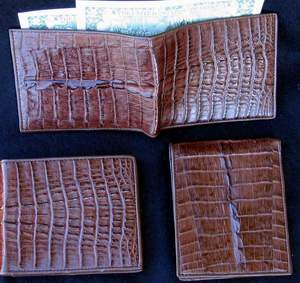
.JPG)
COLORS?
Alligators are naturally colored to be camouflaged in their green and brown surroundings, so their skins are naturally a dull combination of Gray-Brown-Green. Thru the tanning and dyeing process, the skins can be dyed to almost any color. While black and browns are the most common colors, beautiful gray/silver, reds, oranges, and blue are also available. Consistency and depth of color is important, and is easier to achieve with the darker or more vivid the color; lighter colors can be inconsistent and discolor easily over time.
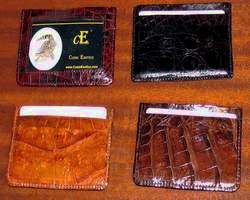
.JPG)
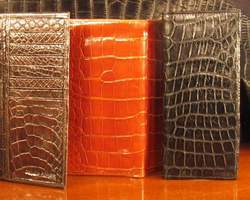
ADDITIONAL COMMENTS ON BELTS:
Virtually all alligator and crocodile belts (99.9%), are made by splicing together 3 to 5 pieces of alligator/crocodile leather. On top quality belts, the alligator/crocodile leather is only a thin top layer of a multi-ply structure. Because alligator/crocodile leather is relatively flexible and elastic, it is the underlying cow leather strap (relatively stiff and inelastic) that takes all of the load.
In the making of top quality belts, care is taken to make sure that the splices are relatively well matched. However on virtually all belts, if you were to carefully inspect the belt, you can easily find the splices (while the color should be consistent, the break in the scale pattern of the leather gives the splices away; splices are at an approximately 75 degree angle to the belt). While the visual match of the splices are a good general indicator of quality, the splices are usually not an issue. Unless the splice is particularly poor, you are not going to see it once the belt is in use. Given that a belt is usually at least a couple of feet away from someone's face/eyes, and the belt is visually broken up by belt loops, the most important visual area of the belt is near the buckle. From a visual and functional stand point, absolutely no splices should be in the area of the belt holes.
While the visual aspects of the splices are typically not an issue, you want to make sure that the splices are tight, and won't get snagged on belt loops and split over time. Also, if there are obviously more than 5 pieces spliced into a normal length belt, don't buy it.
BELT SIZING GUIDE:
To get the best fit when buying a belt on-line, it is important to select the correct size based upon an accurate measurement. Your belt size is not the same as your pant or waist size; because your belt goes around you and your pants, your tucked in shirt, and your underwear, your belt size is usually 1 or 2 inches larger than you pant or waist size. The leading manufacturers of quality belts share the same standard for measuring and labeling belt sizes. This measure is based upon the length of the belt strap only, and does not include the buckle.



THE BEST METHOD TO MEASURE YOUR "BELT SIZE" :
When ordering a belt on-line, the best way to assure the proper fit is to measure one of your existing belts that fits you well. To do this, carefully stretch out the belt on a flat surface, and using a measuring tape, measure from:
A) where the buckle attaches to the belt,
to:
B) the hole on the belt that fits you best.
Refer to the diagram below (Note: Do not measure to the middle hole; measure to the hole that fits you best).:

That is your belt size. If you anticipate a change in your waist size (we all trend larger), you can add or subtract one inch from this measurement. Your new belt will be based upon this measurement.
On your new belt, that same dimension will be the measurement from where the buckle attaches to the belt (A in the above), to the center hole. From this center hole most belts have two punched holes longer (at one inch increments) and two punched holes shorter (at one inch increments); this arrangement gives you the widest relevant range in adjusting your belt.
CONVERTING INCHES TO CENTIMETERS:
If you would like some help converting from/to metric, the following table may be of assistance:



ADDITIONAL CONSIDERATIONS:
1) While the methodology described above, has remained the standard in the world of belt manufacturers and haberdashers for decades, some less regarded manufacturers/vendors include the length of the buckle in their measurement. At first this may appear to be logical since the throw of the buckle (internal length of the buckle), adds to the effective length of the belt around your waist. However, since buckles vary in size, shape and length, including the length of the buckle adds another variable to the measure of belt size; a belt's length would depend on which buckle your wearing. If this were the industry standard, how would you measure belt straps? Although this alternative measurement is flawed, a minority of manufacturers use it.
2) Do belts stretch out over time, such that I should order a belt that will stretch to the correct size? Well, yes and no. While leather does stretch over time, a premium quality belt would take a year or more of daily use to potentially stretch up to one-half inch.
FOR MORE INFO:
If you have any questions, please contact us at info@xbelts.com (xbelts is short for Executive Belts), and please visit our eBay store .
Through our premier "Esotico" line of custom-made belts (in Genuine Alligator, Crocodile and other fine leathers), we represent the largest producer of premium quality Alligator, Ostrich and Lizard belts in the USA. Buy direct form us and save up to 40% on belts identical (made by the same leather artisans, using the same ultra premium quality alligator skins), to Cole Haan Alligator Belts, Trafalgar and Orvis.



BUYING AN ALLIGATOR OR CROCODILE WALLET ???
Few items are more personal and more useful to you on a daily basis than your wallet. In addition to your watch and keys, you are probably going to carry your wallet with you everywhere that you go. And like your watch, it says something about you (to yourself and to others).
BASIC REQUIREMENTS FOR YOUR WALLET:
Your wallet needs to be:
1) FUNCTIONAL in safely holding all the items that you deem critical,
2) PRACTICAL in size, shape, comfort in carrying, and in it's relative cost over its useful life
3) STYLISH as an indication of your sense of style.
In each of these areas, alligator, crocodile and other exotic leather (especially stingray) wallets have significant advantages over all other wallets, particularly wallets made from cow/calf leather. Typically, the only perceived disadvantages to an alligator or crocodile wallet is its initial cost (not its cost per year over its useful life) and a difficulty in finding a selection of premium quality wallets to choose from.
This guide explores all of these issues.
As in buying in anything of value, do some research and only buy from people with a solid reputation. Because of the premium prices commanded by alligator and crocodile items, there is a great deal of mislabeling and misrepresentation of the animal species and the quality of the skins. Be careful, but don't be discouraged from buying a beautiful gift for someone special, including yourself
STYLES / FORMATS OF WALLETS:
There are four basic styles for mens wallets:
1) Standard / Hipster (a.k.a. "US-style" ) Horizontal Format :
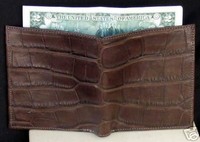
By far the most common type of wallet in the USA. Named "Hipster" because it is most often carried in a man's hip-pocket, or the back pocket in a pair of pants. Available in a range of sizes, including the most common 6 or 8 pocket bilfold/billfold/bi-fold (referring to credit card pockets; some larger versions hold 10 or 12 credit cards) It is generally the size and shape of a US Dollar Bill.
Variations include various flip-up/flip-out sections, ID windows, and due to increased need to show your ID, a "Pass Case" version that has a removable section to hold your ID and maybe a credit card and some cash.
Another variation is the tri-fold (which could also be classified in the Vertical format below); these are for guys that can't quite crap enough stuff into a regular wallet. You probably know or have seen someone with an >2" thick wallet with all of their "essentials" in it . Since no one can actually sit all day on a wallet like this, most tri-folds often are carried around by hand like a purse.
2) Vertical Format, "a.k.a. Hong Kong -style":

Is taller than it is wide. While it is wide enough to hold an unfolded US Dollar Bill, it is designed to hold some of the much taller foreign currencies as well. Like the standard format (above) these Vertical Format wallets have variations that include various flip-up/flip-out sections and ID windows.
3) Front-Pocket Wallet :
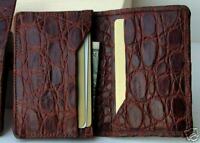
An increasingly popular design as more men recognize that they have relatively few items that are so essential, as to be on your person at all times. While a US Dollar Bill must be folded (in half or thirds) to fit inside, these smaller format wallets have plenty of room for your drivers' license, 2 to 4 credit cards and several business cards or the equivalent.
Users of these wallets often use a money clip to hold the smaller dollar denominations, which has the benefit of being able to keep your wallet in your pocket while paying for most items/activities.
The added advantages of this format is that your wallet is more secure from pick-pockets, and that you can avoid the potential health issues in nerve damage from sitting on a larger wallet all day.
4) Breast-Coat Pocket (aka "Long" Wallet, or Lapel Wallet):

Associated with a more sophisticated European look (this is the kind of wallet that James Bond carries in his dinner jacket), this format is the most elegant, and in today's less formal world, the least practical. Well-suited for special occasions and for traveling, these large wallets can be expensive, especially when made in alligator. For all of these reasons, most men who use this format also have a primary day to day wallet.
With a little care your exotic leather accessories can serve you well for many years and be a source of pride every day.
Nature gave reptiles and other primitive species like stingrays, armor-like skins as a primary defense against predators and as an extremely moisture tolerant barrier from their aquatic environments. Compared to cow and other mammals with relatively soft skins (and hair; you don't want a hairy belt or wallet?), the exotic leathers offer significant practical advantages in addition to their beautiful textures, colors and finishes. While a top quality cow leather wallet may serve you for 2 years or so, a premium quality exotic leather wallets should serve you well for at least 5 or 6 years.



Periodic Care
The best way to care for an exotic leather accessory is to simply keep it clean and dry. Do not (repeat; do NOT) use cleaning or conditioning products designed for cow leather; such products will damage most exotic leathers.
Ideally, you should clean your alligator, crocodile or other exotic leather accessory every few months with a clean damp cloth or with a cleaner specifically intended for such exotic leathers. After a cleaning, it is very important to condition the leather to replace the lost emollients and to moisturize and reseal the leather. A great natural product to condition, moisturize and reseal exotic leather is beeswax. A light coating of extra fine beeswax, gently rubbed into the leather and then lightly buffed off, is all that is required to preserve and protect the skin. Some of these beeswax products may include carnuba wax. Several sellers on eBay offer such products, or you can search google for "beeswax leather care".
Reptile skins are fundamentally different and more complex than cow leather, in that a reptile's scales are held together with membranes. While the scales are relatively rigid and armor-like, it is the membranes that allow for the flexibility. It is important to properly moisturize and re-seal these membranes; with proper care your exotic leather can remain flexible and look great for a decade or more.
Note: it is strongly recommended that you test any cleaning or conditioning product on a small inconspicuous area to test for discoloration, before you proceed in using the product.


Quality of Skins and Tanning Procedures is Important
As discussed in our other guide "Alligator & Crocodile Buyers Guide", the underlying quality of the skins is critically important to the look, feel and durability of your exotic leather accessory.
Unfortunately, most of the alligator and crocodile items sold on eBay have overly dry skins(to the point of permanent damage). While these items can look good in photos, the tanning processes in Central and South America leave the skins very dry and prone to cracking. Once the skins become this dry, it is difficult to even partially remoisturize them.
Some of the products from Asia share this problem, but to a much lesser extent.
The only way to know if the skin is flexible and supple, is to hold it and manipulate it in your hands. So, unless the seller of the item has a reasonable return/refund policy, do NOT buy it.
Repairing Damaged Skins
Most good quality exotic leather skins can take a great deal of abuse before they become truly damaged. Beyond scratches and cuts to the external surface, damaged skins can become very dry and stiff. Depending upon the level of damage, some TLC with careful moisturizing and resealing (as noted above) can often fully restore exotic leather.
For extreme cases, drastic steps can rescue damaged leather, however the risk is significant discoloration. If the item is already black or dark brown the level of discoloration is limited; lighter colored skins can become very dark (sometimes almost black). Using neatsfoot oil (or if you cannot find neatsfoot oil, use mineral oil or unscented baby oil), carefully rub a very thin, even layer of oil on your hands before you touch the exotic leather item. Then evenly rub the oil into the leather item. Keep a towel handy to periodically dry off any excess oil. Wait a few minutes before reapplying oil, since the oil soaks in at different rates depending upon the leather's dryness and the scale pattern. After woking the oil into the leather, work the item for flexibility. Use the towel to completely dry off the item, then set the exotic leather aside overnight. Carefully reapply a very light coat of the oil to even out any discoloration, then completely dry the item before use.
FOR MORE INFO:



If you have any questions, please contact us at info@xbelts.com (xbelts is short for Executive Belts), and please visit our eBay store .
Through our premier "Esotico" line of custom-made belts (in Genuine Alligator, Crocodile and other fine leathers), we represent the largest producer of premium quality Alligator, Ostrich and Lizard belts in the USA. Buy direct form us and save up to 40% on belts identical (made by the same leather artisans, using the same ultra premium quality alligator skins), to Cole Haan Alligator Belts, Trafalgar and Orvis.


MORE INFO?
For detailed on alligators and crocodiles in their wild state, please Google "Wikipedia , alligator" or Wikipedia , crocodile".
OR CONTACT US AT: COLLETTE@xbelts.com





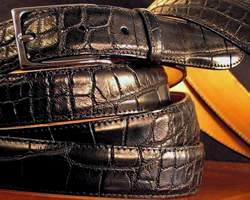
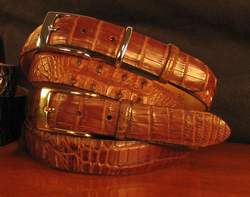
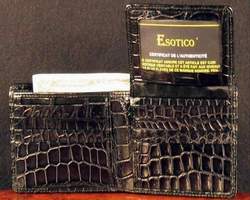
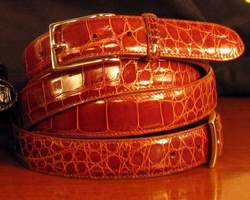




.JPG)

.JPG)
